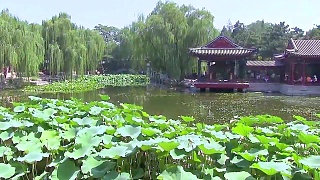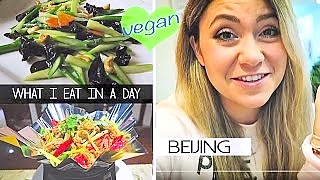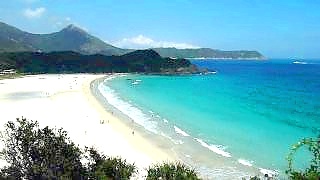Beijing is a food lover's heaven! As you would expect in such a large and varied country, there are many regional cuisines - and you can find them all in Beijing, plus Korean, Japanese, Thai and Western dishes.
HotPot
Hot Pot is a varied and interesting 'cook by yourself' experience. You choose what to eat and the ingredients are prepared and arrive ready to cook. The common ingredients are meat (mutton, chicken, beef) and fish, plus various types of Tofu, mushrooms, eggs, noodles and many kinds of vegetable. These are cooked in a 'soup' that is heated by gas, electricity or flame.
Meat is prepared by being thinly sliced while frozen. When added to the gently bubbling soup, it cooks in about 30 seconds. Leafy vegetables and thread noodles cook even quicker. However, starchy vegetables, such as potato and yam slices, need a few minutes. Tofu and mushrooms perhaps 2 minutes or so.
Hot Pot comes in basically two styles - Sichuan and Mongolian. Both are commonly found in Beijing.
Sichuan hotpot involves a sesame paste 'dip' made from ground sesame seeds (paste) and sesame oil. Other dip types are sometimes available. The sesame dip is often topped with coriander. Other condiments are also usually available, including garlic, spring onion and chilli oil, to add either to the soup or dip.
Barbecue Restaurants
Similar to Hot Pot restaurants in the sense that you order the ingredients and cook them yourself - in this case by barbecue grill. One would normally order condiments and side dishes also.
'Small Eats' Restaurants
These informal cafe restaurants have a wide range of not so small (!), cheap and quickly prepared dishes, featuring a large range of staples. Look for the red and white sign as shown above.
The Chengdu and Sichuan versions are particularly good; the dishes are not all hot and even the spicy ones are not too hot in Beijing. Many dishes come with or without rice. Noodle soup dishes are many people's favorite, as is Kung Po chicken - boneless chicken pieces in a slightly spicy sauce with peanuts, spring onion and cucumber. Another popular, spicy dish is Mapo Dofu - soft tofu beancurd with minced pork in a rich sauce. Anothe is DiSanXian - eggplant, peppers and potato. And egg with tomato or peppers.
Roast Duck
Beijing's most well-known contribution to the world of gastronomy is its delicious, and incredibly moreish, Beijing Duck.
After being marinaded in a mysterious deep-red sauce, ducks are roasted directly over flames stoked by fruit-tree wood until crisp, then sliced thinly and served with small pancakes with a black bean sauce, cucumber and spring onion.
The QuanJuDe (which has branches in Qianmen, Hepingmen or Wangfujing) and BianYiFang dishes among the most popular variations, each using a different method of preparation, spices and sauces, but both producing wonderful results.
Teriyaki
Japanese style quick fry, with just a little oil, on a hot plate just in front of you.
Dim Sum
Cantonese style snacks.
Imperial Court Food
Imperial Court Food is a style that has its origins in the Imperial Palace - it is based on the foods that were served to the emperor and his court. There are several places where you can sample these rather unique dishes. The Fang Shan restaurant in Beihai Park and Ting Li Guan restaurant in the Summer Palace are perhaps the best two.
Some of these dishes will seem rather strange to the western palate - and quite expensive too. For the true gastronome.
Shopping Centre Food Courts
All the large shopping centers and indoor markets have these, usually at the basement level or top floor. The quality ranges from good to excellent, depending on what part you visit.
On the lower ground floor of the Oriental Plaza one can find a wide range of restaurants and cafes; among these is the MegaBite, which itself has dozens of types of food and is well worth a visit.
Outdoor Dining
Beijing has very warm evenings from May to September (inclusive) and so outdoor dining is very popular in these months.
Side Dishes / Entrees
Many restaurants, especially Korean ones, provide free small side dishes, often as entrees, such as the one shown below. Nuts, seeds, beans or dried fruit are often provided free as nibbles.
Western Style Food
There are about 1000 McDonalds, KFC and Pizza Hut restaurants in Beijing. At McDonalds, prices are about 1/3 of those in the West. Pizza Huts have similar prices to the West but the service and decor in these are particularly good.
Ice-Cream Parlours
These include the popular Haagen Daaz.
Drinks
Try something different with your meal, such as haw juice, almond juice or coconut milk. Or how about flower 'tea' (infusion), such as Chrysanthemum or 'Eight Treasure Tea' - much nicer than you might think!
If you would like to buy some teas to take home, you'll find tea shops have more choice than you dreamed possible. An excellent choice is ***.
You might also like to try 'Pearl Milk Tea' - an iced tea based drink that also contains small balls of tapioca that are sucked up through a wide straw. The drink may also contain milk and fruit pulp - in fact there are many varieties available.
The local Yanjing beer is cheapest (3 yuan in an everyday restaurant). There are a number of higher quality versions that are avaiable in restaurants a little up market (often 10 yuan). TsingTao beer is generally rated as better than Yanjing and is also common in Beijing. Expect to pay more for western lagers (an unnecessary choice) - and much more in bars and clubs.
Wine is a fast growing drink in China - and a fast growing industry. Local wines are often made with French know-how and investment. 'Great Wall' is perhaps the best known brand but there are many others.
Street Snacks
Don't be afraid of the street food - in Beijing it's amongst the best in the world, and you'd be missing out on a crucial part of the city's cultural life if you chose to eat exclusively in the (many) top class restaurants.
Beijing has over 250 types of traditional snack foods, freshly prepared and served fast. Many of them are made of glutinous rice, soy beans or fried materials.
Some types of street snack appear at different times of the day. For example, HongShu (sweet potatoes baked in their skins), a filling, quick snack, perhaps served with diced lamb or chilli, appear in the afternoon. Then there are the night markets where steaming stalls appear, as if by magic, when the sun sets.
One very palatable snack found in many places is shown below - meat or fish on bamboo skewers that are deep fried then optionally coated with cumin seeds and herbs and/or chilli powder.
7/11 stores often have hot take-away dishes.
Vegetarian
All restaurants have many delicious vegetable only dishes.
There are also specialised vegetarian restaurants that also offer dishes that mimic meat dishes, often based on various types of tofu. Every dish in the following picture is vegetarian.
JiaoZi and BaoZi
These are both types of chinese dumplings. BaoZi are more like stuffed buns and are steamed. JiaoZi are made from thinly rolled dough and sealed by crimping; they can be steamed or cooked in other ways (fried or boiled). JiaoZi are often served with a dip of soy and vinegar or chilli sauce. Both may contain either meat or vegetable fillings.
Note that JiaoZi and BaoZi are different from wontons (a south china dish) which look similar but are served in a soup.
Lunch Boxes
Popular with some office and shop workers.
Cakes
These include sesame seed coated buns, often containing pumpkin or red bean paste and served hot in restaurants.



















































Beijing, the capital city of China, is a vibrant metropolis steeped in history, culture, and modernity. Here's a brief overview of what you can expect as a tourist in Beijing:
Historical Landmarks:
The Great Wall of China: One of the most iconic structures in the world, the Great Wall is easily accessible from Beijing. Mutianyu and Badaling sections are popular among tourists.
Forbidden City (Palace Museum): A UNESCO World Heritage Site, this vast imperial palace complex was home to Chinese emperors for over 500 years. It houses numerous halls, courtyards, and historical artifacts.
Temple of Heaven: A masterpiece of Chinese architecture, this ancient temple complex served as a place of worship for emperors to pray for good harvests.
Summer Palace: A stunning ensemble of lakes, gardens, and palaces, the Summer Palace served as a retreat for emperors during the Qing dynasty.
Tiananmen Square: One of the largest city squares in the world, Tiananmen Square is flanked by important landmarks such as the Monument to the People's Heroes, the Great Hall of the People, and the Mausoleum of Mao Zedong.
Cultural Sites:
Beijing Hutongs: Explore the narrow alleyways and traditional courtyard residences of Beijing's historic neighborhoods. You can take a rickshaw tour or simply wander around on foot.
Beijing Opera: Experience traditional Chinese opera performances at venues like the Liyuan Theater or the Chang'an Grand Theatre.
798 Art District: A hub of contemporary art and culture, this former industrial area is now home to numerous galleries, studios, and cafes.
Modern Attractions:
Olympic Park: Visit iconic structures such as the Bird's Nest (National Stadium) and the Water Cube (National Aquatics Center) from the 2008 Beijing Olympics.
CBD (Central Business District): Marvel at the futuristic skyline of Beijing's modern business district, which includes landmarks like the CCTV Headquarters and the China World Trade Center Tower III.
Culinary Delights:
Peking Duck: Indulge in Beijing's most famous dish, crispy roast duck served with pancakes, scallions, and hoisin sauce.
Street Food: Explore the city's vibrant street food scene and sample local delicacies like jianbing (savory crepes), lamb skewers, and dumplings.
Practical Tips:
Transportation: Beijing has an extensive public transportation system, including the subway, buses, and taxis. However, traffic can be heavy, so plan your travels accordingly.
Language: While English is not widely spoken, especially outside tourist areas, many signs and transportation announcements are in English. It's helpful to carry a translation app or a phrasebook.
Weather: Beijing experiences four distinct seasons, with hot summers and cold winters. The best times to visit are spring (April to June) and autumn (September to October) when the weather is mild and comfortable.
Etiquette: Respect local customs and traditions, such as removing your shoes before entering someone's home and using both hands to pass or receive items.
Beijing offers a rich tapestry of experiences for tourists, blending ancient heritage with modern innovations. Whether you're fascinated by history, culture, or culinary delights, there's something for everyone in this dynamic city.
Chinese cuisine is an intricate tapestry of flavors, techniques, and regional specialties that has evolved over thousands of years. From the fiery spices of Sichuan to the delicate dim sum of Cantonese cuisine, every region of China offers its own culinary delights. For visitors to China, exploring the diverse and dynamic world of Chinese food is an essential part of experiencing the country's rich cultural heritage. Here's a more extensive exploration of Chinese cuisine for visitors:
Regional Diversity:
Sichuan Cuisine: Hailing from the southwestern province of Sichuan, this cuisine is famed for its bold, spicy, and numbing flavors. Sichuan peppercorns, chili peppers, and aromatic spices are used liberally in dishes like Mapo Tofu, Dan Dan Noodles, and Sichuan Hot Pot, creating a symphony of flavors that tingles the taste buds.
Cantonese Cuisine: With its emphasis on fresh ingredients and delicate flavors, Cantonese cuisine is highly regarded for its seafood dishes, roasted meats, and dim sum. Steamed fish, Char Siu (barbecue pork), and Har Gow (shrimp dumplings) are just a few examples of the exquisite dishes that showcase Cantonese culinary mastery.
Shanghai Cuisine: Reflecting its coastal location and cosmopolitan history, Shanghai cuisine combines influences from Jiangsu, Zhejiang, and Anhui provinces. Sweet and Sour Mandarin Fish, Shanghai Soup Dumplings (Xiaolongbao), and Drunken Chicken are some of the signature dishes that highlight the diverse flavors and textures of this culinary tradition.
Beijing Cuisine: As the capital of China, Beijing boasts a rich culinary heritage deeply rooted in imperial traditions. Peking Duck, a dish with crispy skin and succulent meat served with pancakes and hoisin sauce, is a quintessential Beijing delicacy. Other notable dishes include Zhajiangmian (Beijing Noodles), Mongolian Hot Pot, and Beijing-style meat pies.
Hunan Cuisine: Known for its bold and aromatic flavors, Hunan cuisine features dishes that are spicy, sour, and intensely flavorful. Chairman Mao's Red-Braised Pork, Dong'an Chicken, and Steamed Fish Head with Chopped Chili exemplify the fiery and robust nature of Hunanese cooking, which makes ample use of chili peppers, garlic, and fermented ingredients.
Street Food and Snacks:
Jianbing: This savory Chinese crepe is a popular breakfast option, consisting of a thin pancake filled with eggs, scallions, cilantro, and various fillings such as crispy fried dough, pickled vegetables, or chili sauce.
Baozi: These steamed buns are filled with a variety of savory or sweet fillings, including pork, vegetables, or red bean paste. Baozi are a popular street food snack and can be found in teahouses, markets, and street stalls across China.
Roujiamo: Often referred to as Chinese Hamburgers, roujiamo features savory braised meat stuffed inside a flatbread, offering a hearty and flavorful snack that's perfect for on-the-go eating.
Dining Etiquette and Customs:
Family-Style Dining: Chinese meals are typically served family-style, with multiple dishes shared among diners seated around a table. It's customary to use chopsticks to pick up food from communal dishes and to serve elders before oneself.
Toasting and Ganbei: When dining with Chinese hosts, expect toasts (ganbei) with alcohol, usually baijiu (Chinese liquor). It's polite to reciprocate the toast and drink in moderation, but declining politely is acceptable if you don't drink alcohol.
Tea Culture: Tea is an integral part of Chinese dining culture, with a wide variety of teas available to complement different dishes. Green tea, oolong tea, and pu'er tea are among the most popular choices, and serving tea to guests is a sign of hospitality and respect.
Street Markets and Night Markets:
Wangfujing Snack Street, Beijing: Located near the Forbidden City, this bustling street market offers a wide variety of traditional snacks, street food, and local delicacies. Visitors can sample everything from scorpions on a stick to traditional Beijing snacks like Jianbing and Tanghulu (candied fruit skewers).
Shanghai Old Street, Shanghai: Nestled in the heart of the city's historic district, Shanghai Old Street is a bustling marketplace where visitors can explore narrow alleyways lined with traditional shops, street vendors, and food stalls. From steamed dumplings and stinky tofu to hand-pulled noodles and sugar-coated haws, there's something to satisfy every craving.
Dietary Considerations:
Vegetarian and Vegan Options: While Chinese cuisine traditionally features a wide range of meats and animal products, vegetarian and vegan options are becoming increasingly available, especially in larger cities and tourist destinations. Buddhist restaurants (????, sùshí c?nt?ng) often offer meat-free versions of classic dishes, and plant-based ingredients like tofu, mushrooms, and seasonal vegetables are widely used in Chinese cooking.
Exploring the diverse and delicious world of Chinese cuisine is an essential part of any visit to China. From regional specialties and street food snacks to dining etiquette and cultural customs, the culinary landscape of China offers a rich tapestry of flavors, traditions, and experiences that are sure to delight and inspire visitors from around the world. Bon appétit!.
 Food in Beijing
Food in Beijing























